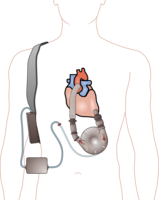
Photo from wikipedia
BackgroundApproximately 70,000 to 75,000 proximal femoral fracture repairs take place in the UK each year. Hemiarthroplasty is the preferred treatment for adults aged over 60 years. Postoperative infection affects up to… Click to show full abstract
BackgroundApproximately 70,000 to 75,000 proximal femoral fracture repairs take place in the UK each year. Hemiarthroplasty is the preferred treatment for adults aged over 60 years. Postoperative infection affects up to 3% of patients and is the single most common reason for early return to theatre. Ultraclean ventilation was introduced to help mitigate the risk of infection, but it may also contribute to inadvertent perioperative hypothermia, which itself is a risk for postoperative infection. To counter this, active intraoperative warming is used for all procedures that take 30 min or more. Forced air warming (FAW) and resistive fabric warming (RFW) are the two principal techniques used for this purpose; they are equally effective in prevention of inadvertent perioperative hypothermia, but it is not known which is associated with the lowest infection rates. Deep surgical site infection doubles operative costs, triples investigation costs and quadruples ward costs. The Reducing Implant Infection in Orthopaedics (RIIiO) study seeks to compare infection rates with FAW versus RFW after hemiarthroplasty for hip fracture. A cost-neutral intervention capable of reducing postoperative infection rates would likely lead to a change in practice, yield significant savings for the health economy, reduce overall exposure to antibiotics and improve outcomes following hip fracture in the elderly. The findings may be transferable to other orthopaedic implant procedures and to non-orthopaedic surgical specialties.MethodsRIIiO is a parallel group, open label study randomising hip fracture patients over 60 years of age who are undergoing hemiarthroplasty to RFW or FAW. Participants are followed up for 3 months. Definitive deep surgical site infection within 90 days of surgery, the primary endpoint, is determined by a blinded endpoint committee.DiscussionHemiarthroplasty carries a risk of deep surgical site infection of approximately 3%. In order to provide 90% power to demonstrate an absolute risk reduction of 1%, using a 5% significance level, a full trial would need to recruit approximately 8630 participants. A pilot study is being conducted in the first instance to demonstrate that recruitment and data management strategies are appropriate and robust before embarking on a large multi-centre trial.Trial registrationISRCTN, ISRCTN74612906. Registered on 27 February 2017.
Journal Title: Trials
Year Published: 2018
Link to full text (if available)
Share on Social Media: Sign Up to like & get
recommendations!